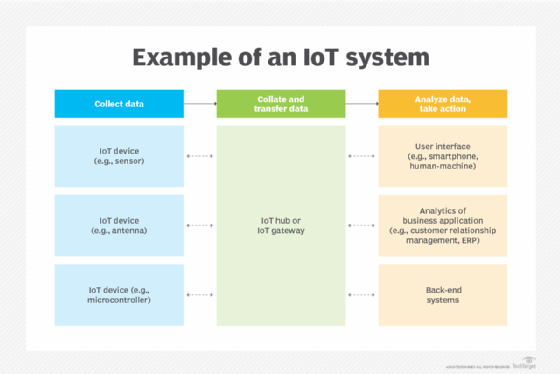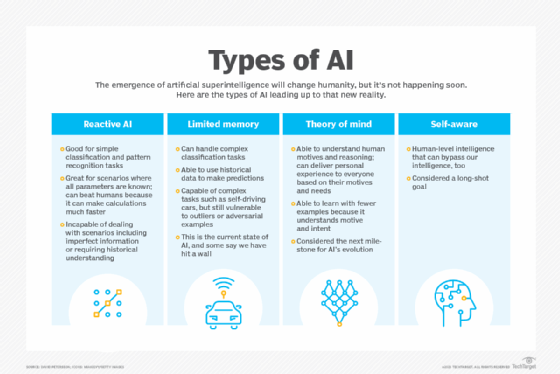AI and IoT: How do the internet of things and AI work together?
AI can compound the benefits of IoT by adding humanlike awareness and decision-making to the environment at hand to ultimately increase efficiency and improve processes.
IoT and AI are two of the hottest topics in tech, which is a good reason why enterprise technologists must understand them. The two technologies can be highly symbiotic, but the most significant opportunities might lie in using them together, so it's critical to plan how they can support each other to benefit enterprise users.
What is IoT?
IoT is a network of devices rather than people. IoT applications are usually built from devices that sense real-world conditions and then trigger actions to respond in some way. Often, the response includes steps that influence the real world.
A simple example is a sensor that, when activated, turns on some lights; however, many IoT applications require more complicated rules to link triggers and control elements to manage processes in real time.
The messages that represent triggers, actions or commands in IoT flow through what's commonly called a control loop. The part of an IoT application that receives the triggers and initiates the actions is the center point of that loop and where IoT rules reside. The control loop is only a part of the total information flow in an IoT application -- the part that receives information on real-world process conditions and generates real-world responses.
Most IoT applications also generate some business transactions. For example, the reading of a shipping manifest at the entry to a warehouse might open the gate for the driver -- a control loop decision -- and generate a transaction to receive the goods represented on the manifest into inventory -- a business transaction.
Decisions made in the control loop must meet application latency requirements, which are often referred to as the length of the control loop.
Control loops often require simple processing to close the loop and create a real-world response to an event. Entering a code to open a gate is an example of this. In other cases, the processing needed to decide is more complicated.
When the processing must apply more decision factors, the time required to make these decisions can affect the length of the control loop and IoT's ability to provide the expected features.
For example, a half-minute delay in having a worker scan a manifest before admitting a truck into a freight yard could reduce yard capacity. IoT could read a QR code on the manifest and make the necessary decisions much faster, speeding the movement of goods.
AI sensors can create mountains of data, much of which has immediate value in process control as well as value in the sense of business analysis and optimization. AI can be used in both these missions, and proper AI usage can increase efficiency and accuracy. But not all AI is the same, and not all types apply to a given control or analysis mission.
Figure 1 illustrates the elements of an IoT application and their relationship to other business applications.

What is AI?
AI is a class of applications that interpret conditions and make decisions, like how people respond to their senses, without requiring direct human intervention.
There are five broad forms of AI in use today, ranging from simple and almost mechanical to complex and nearly human:
- Simple or rule-based AI. This is software with rules or policies that relate trigger events to actions. These rules are programmed, so some people might not recognize this as a form of AI. However, many AI platforms rely on this strategy.
- Machine learning. ML is a form of AI where the application learns behavior rather than having it programmed in. The learning can take the form of monitoring a live system, relating human responses to events and then repeating them when the same conditions occur by analyzing past behaviors or having an expert provide the data. A combination of application and ML experts can also teach ML. There is a general trend to convert an ML rule set to hardware and semiconductor implementation.
- Inference or neural networks. These networks use AI to build an engine designed to mimic a simple biological brain. The engine makes deductions that generate responses to triggers based on what it infers about the conditions. Like ML, this technology is increasingly applied to image analysis and complex analytics in hardware or chip-based systems.
- Language models and agentic AI. As hybrids of neural technology and ML, language models and agentic AI build data sets by analyzing information. Language models learn by examining things, and the model's size limits the complexity of what it can learn and do. Generative AI (see below) is an application of large language model (LLM) technology, and most agentic AI systems are based on large or small language models.
- Generative AI. GenAI, popularized by ChatGPT, builds a knowledge base by examining millions of online documents and then answers plain-language queries based on that knowledge and a set of rules provided by engineers. The breadth of the knowledge base and the sophistication of the rules that govern queries can make this form of AI seem human, and it represents the state of the art for many involved in the field. However, generative AI requires enormous data centers to run and online documents with the scope of the internet to train.
All these forms of AI are designed to stand in for human intelligence, but their ability to represent something even approaching human intelligence is greater as you progress through the five in the order above. It's also possible to classify AI systems based on how they progress toward intelligence, as Figure 2 shows. Most AI experts would say that the current state of AI art falls in the reactive and limited memory categories and that AI experimentation aims to advance toward self-aware systems. Most enterprises say they are targeting the middle AI classes, limited memory and theory of mind.

How can IoT and AI support each other?
In IoT, real-world events are signaled and processed to create an appropriate response. In a simple sense, then, any IoT application that uses software to generate a response to a trigger event is at least a basic form of AI, and AI is then essential to IoT.
The question for IoT users and developers isn't whether to use AI but how far AI can be taken to support IoT applications. That depends on the complexity and variability of the real-world systems IoT supports and the specific kind of AI being considered.
To answer the question, we'll look at the three most common and promising AI missions: enhancing control loop processing, supporting more complex real-world activity and extending IoT beyond the traditional control loop into business management.
Simple AI rules enhance IoT benefits
IoT control applications create actions based on IoT events created by sensors or other IoT devices. Simple, rule-based IoT would say, "If the trigger switch is pressed, turn on light A," and a more sophisticated evolution might say, "If the trigger switch is pressed, and it's dark, turn on light A." This second form represents event (trigger switch) recognition and state (it's dark) recognition. Programmers use state/event tables to describe how a series of events are interpreted in multiple states, but this only works if there are a limited number of states that can be easily recognized.
AI can add value to rule-based IoT applications in several ways:
- AI can use multiple sources of information to determine the state, such as whether a space is currently occupied, whether it's so cloudy that normal sunlight doesn't supply illumination, whether it's a weekend or holiday, etc. This kind of refinement improves the utility of the application.
- AI can take action based on a combination of IoT-recognized conditions. For example, it can read a QR code, barcode or RFID tag on a vehicle and analyze a driver's face and/or voice to decide whether to open an access gate to a truck at a warehouse. It can also evaluate whether a specific delivery or pickup is unusual in any way and alert a person to intervene.
- AI analysis of audio and video information can be used to generate IoT events from real-world sensory data. Motion and person detection is already a common example of video analysis applications, and speech recognition and speaker association can also add value to rule-based IoT by personalizing actions taken.
- AI can check the state of a large number of IoT sensors and determine if the combination represents a condition previously identified as a fault or risk and take appropriate action. This is already being done in public utility and transportation verticals, where the health of the system overall is based on too many variables for easy human analysis.
- AI can fit the state of a facility to a combination of environmental conditions and business activity. For example, it can control lighting and HVAC to respond not only to current conditions but also to events that would require unique responses. A group of vehicles arriving at a warehouse might open the facility to outside air and thus require a different HVAC setting, for instance. Similarly, loading and unloading vehicles might require different lighting than vehicles with no loading or unloading needed.
All these things could be done using new IoT programming, but an AI model designed for the task and modified as needed -- now popularly called a foundation model -- could handle much greater levels of complexity without requiring program development.
Most rule-based AI applications are based on simple models, including inference AI and ML. These applications are autonomous in that they don't require human oversight or operate in a way intended to assist or advise a person. They are limited to handling the control loop that connects IoT events and the actions to be triggered. More advanced and complex AI missions in IoT are also emerging.
AI assistants and agents in IoT applications
The language model form of AI is currently at the forefront of AI applications in general and is the specific use case of AI in IoT. Large and small language models (SLMs) can function almost like an expert or specialist, producing art, music, video, reports and even programming code. Generalized LLMs are beyond the scope of what enterprises would typically deploy on their own and so require cloud hosting. This has created enterprise pushback on the grounds of data sovereignty and security.
The primary application of LLMs and a growing application for SLMs is using a chatbot to replace call center agents in customer support and product purchase assistance missions. There is growing interest in incorporating IoT data from telecom or utility infrastructure systems to support missions in these verticals.
The use of SLMs, pretrained foundation models and schemes to introduce user data into retrieval-augmented generation considerably lowers model hosting and training costs, to the point where self-hosting is practical. This has driven interest in agentic AI because enterprises retain data control, and self-hosted agentic AI can be located within industrial processes, making it a viable way to support this class of IoT. Agentic AI also lets multiple, simple-rule IoT applications be collected under a higher-level AI entity, supporting complex real-world activity.
Applications of agentic AI in IoT include the following:
- Smart facilities, and even smart cities, where orchestrated sets of AI agents are linked to control an entire environment.
- Autonomous vehicles, such as those used in transportation systems for goods and people and, increasingly, to control drones and drone swarms; some industry members have even proposed agentic IoT to augment air traffic control.
- Military applications for land, sea and air warfare and logistics -- again, including the direction of drones and drone swarms.
- Industrial automation for all forms of manufacturing.
- Healthcare, for patient monitoring, reading of diagnostic blood tests and imaging.
- AI-augmented utility and network operations systems, which can provide human specialists with diagnostic information and recommend remedies if there's a problem.
Taking IoT beyond the control loop
Most enterprise IoT applications, including the example of trucks arriving at a warehouse, have a dimension beyond the control loop of authorizing access. For instance, the following questions might be considered:
- Is the truck there to load or unload?
- Is it late?
- Are there other tasks that must now be scheduled or rescheduled?
These questions don't need to be answered in real time, but they do need to be answered to complete the set of business processes related to the truck's arrival -- processes currently supported by traditional core business transactional applications.
Public cloud providers offer APIs that can link an AI model to a database or traditional application workflow. Many AI tools also provide the ability to orchestrate multiple related tasks, some of which can be implemented using AI. All of this is helping IoT better incorporate with business processes, creating what's almost a smart enterprise in the same way that integrated IoT models create a smart city. This can significantly enhance the efficiency of business operations by using data from all real-world activities to develop a vision of the state of the enterprise.
Challenges of AI in IoT applications
Enterprises are generally bullish about AI and IoT, but the following three issues can derail an application:
- AI models, particularly LLMs, are prone to hallucinations that result from misinterpreted training data. Also, the inadvertent use of AI-generated data to train AI models can cause data pollution. These errors discourage the use of AI in truly autonomous applications, but even human oversight doesn't catch them all.
- Training AI on company-specific data is essential for most practical AIoT applications, but this data is normally subject to strict security and governance restrictions, which requires it to be self-hosted. Building the infrastructure to run an AI model can be expensive and requires skills not easily obtained in the job market.
- AI processing -- particularly with language models -- can take time, creating control loop latency that threatens the application's ability to manage a real-time process. This is particularly true in industrial IoT. Machine learning and SLMs might be preferred where latency is critical.
Conclusion
Although IoT aims to improve productivity and reduce human work, it doesn't eliminate the need for human judgment and decisions. That's where AI can step in and improve IoT systems, provided that the AI capabilities are a step above rule-based IoT programming and controllers, and the use of AI doesn't introduce delay in the control loop, which could compromise real-time control.
AI is evolving so rapidly that it's difficult to classify new products and capabilities effectively. This complicates long-term AI project planning, as changes in AI can significantly affect product choices and even the business case. Enterprise AI experts recommend adopting a modular approach, addressing elements of an IoT application -- such as the control loop -- before expanding to incorporate and integrate more information.
Tom Nolle is founder and principal analyst at Andover Intel, a consulting and analysis firm that looks at evolving technologies and applications first from the perspective of the buyer and the buyer's needs. By background, Nolle is a programmer, software architect, and manager of software and network products. He has provided consulting services and technology analysis for decades.






